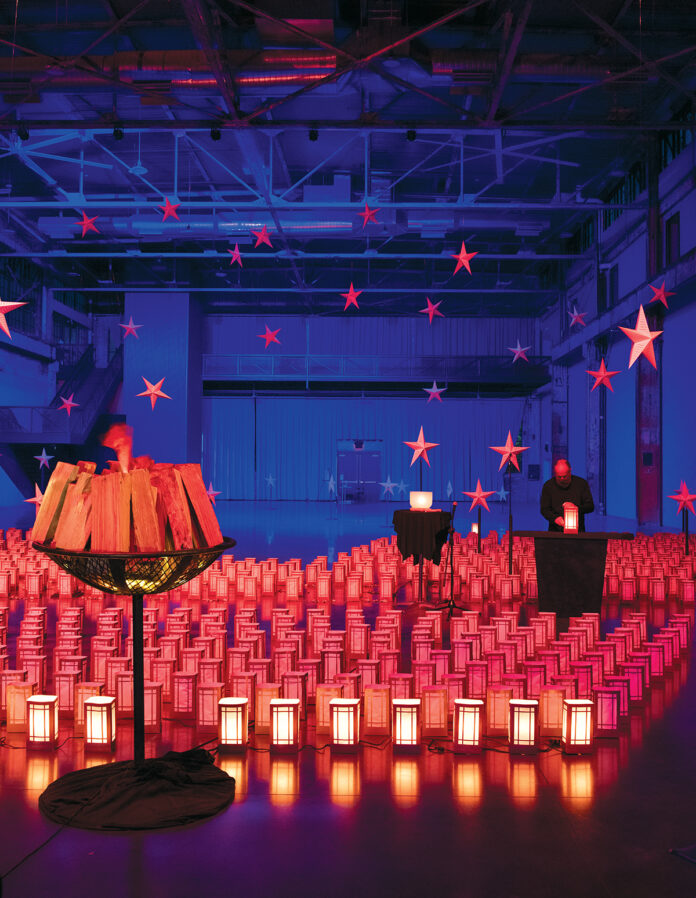WaterFire Providence entered 2020 with big plans.
The nonprofit arts organization was preparing to mark the 25th anniversary since the first fires were lit on the rivers in downtown Providence. WaterFire, which years earlier had been a spark for the city’s renaissance, had corporate sponsors committing for what it thought could be as many as 18 lightings for 2020.
Organizers even had planned a gala Fire Ball for the weekend of Halloween, to be held at the WaterFire Arts Center, three years after converting what had been a 40,000-square-foot industrial building into a premier event and exhibition hall.
But in March, WaterFire Managing Director Peter Mello assembled the employees in that same event space and broke the bad news: The facility would be closing because of the initial surge of COVID-19 infections and a shelter-in-place order issued by the state.
“The idea was we were going to try to continue, and keep this team together, and work remotely,” Mello said. “My job was to try to keep everyone excited about the challenges, and to survive.”
That job only became more difficult when river lightings were canceled, ending corporate sponsorships that annually provide more than half of WaterFire’s $3 million budget.
The confluence of the Providence, Woonasquatucket and Moshassuck rivers at Waterplace Park – where the river lightings have drawn tens of thousands of spectators for years – would remain dark.
Months later, the fight to survive continues to play out not just at WaterFire but at many arts venues and nonprofit arts organizations in Rhode Island that pay bills and salaries from ticket sales and corporate sponsorships that have largely dried up. And beyond the organizations themselves, the vacuum left behind in some cases threatens the region’s ability to draw tourists and business travelers, and the spending money they bring with them.
Kristen Adamo, CEO and president of the Providence Warwick Convention & Visitors Bureau, pointed to the signature river lightings of WaterFire as an example. Such unique events are selling points when trying to woo out-of-state convention organizers.
“WaterFire is essentially the face of tourism in Providence,” Adamo said.
‘INTERESTING EXERCISE’
WaterFire has adapted, making use of its facilities as it can and using technology to extend its reach to new audiences. But those efforts don’t come close to paying the bills.
This year, the organization has collected about half of its typical revenue, with corporate sponsorships alone dropping by $1.5 million. To keep going, the organization has laid off several people. The 15 who remain employed are working only 20 hours a week, under a state work-share program that provides them with unemployment for the remaining hours.
Under the direction of Mello and founder and Executive Artistic Director Barnaby Evans, the organization has hosted a series of virtual and in-person events that comply with the COVID-19 health guidance.
One event was a luminaria lighting at the WaterFire Arts Center from April to August, honoring the people who have died of COVID-19. This month, with the Providence-based Wilbury Theatre Group, it is hosting the play “Constellations” on an outdoor stage in the arts center parking lot.
Some sponsors converted the underwriting of WaterFire lightings into financial grants, contributing about $350,000 to the WaterFire Relief Fund.
Performances and projects have all had contributions or fees. But none of it replicates five months of river lightings.
Mello acknowledged that he frets about the finances.
“I’m an arts leader. I guess we have hope and optimism and some confidence,” he said. “But I’m also a business leader. Every day, I’ve got to be realistic about things.”
Evans, the executive artistic director, said the construction of the outdoor stage is an example of the creativity the pandemic has sparked.
“In terms of creative thinking, it’s actually been a really interesting exercise,” he said. “In terms of the financial stability of the organization, it’s been a huge challenge.”
ABSENCE FELT
The ability of WaterFire, as well as other large arts and performance venues, to rebound quickly is critical to the city’s identity and economics, according to community leaders.
Neil D. Steinberg, CEO and president of the Rhode Island Foundation, said the arts are vital in times of crisis. These organizations often rely on ticket traffic, but due to the pandemic many families are having either health or economic concerns that keep them home.
“Yes, they employ a lot of people,” Steinberg said of the arts community. “But they’re dependent on people being employed to go.”
Moreover, demand for the basics such as food, rent, health care, and behavioral and mental health “just overwhelm everything,” Steinberg said. “While the arts are important, it’s side by side with these incredible, immediate needs.”
What is Providence missing without WaterFire?
The river lightings, which generally occur from May through October, contribute about $114 million in economic output through people visiting Providence, which in turn has created almost 1,300 jobs, according to the organization’s filing with Guidestar, an online information service on nonprofits.
Typically, about 60,000 to 100,000 people come to each lighting, WaterFire said.
“I don’t think I’ve ever done any collateral material on Providence that didn’t have a big picture of WaterFire on it,” Adamo said. “It’s one of those things that’s truly unique to the city of Providence. When you’re looking at the overall brand and the reputation of the city, WaterFire is a key component.”
It accounts for hotel occupancy on the weekends of the events, she said, pushing most hotels into a 90% occupancy rate. And it supports a range of smaller businesses all along the WaterFire route, following the rivers. More than half of the WaterFire attendees come from outside Rhode Island, according to the organization.
Because of that, Adamo and other public officials desperately tried to schedule a series of smaller, holiday-themed WaterFire lightings in December that would have been free and would have featured a system to assure social distancing. But Rhode Island’s recent surge in COVID-19 cases scotched that effort, she said.
“At the end of the day, once the surge started, the little group of us that was trying to make it happen just didn’t think it would be responsible,” she said. “We had to table that.”
Along with venues such as Trinity Repertory Company and the Providence Performing Arts Center, WaterFire is among the “tent pole” organizations of the arts community, she said. It’s important that they all survive the pandemic, particularly for an economic recovery.
“It’s a great sales tool for us; and selfishly, we need it,” she said of the power of the large players to drive tourism and convention business.
Adamo is equally concerned about what she called “second-tier” arts events and venues, such as the Rhode Island International Film Festival, operated by the nonprofit Flickers – The Newport Film Society & Arts Collaborative.
“They don’t have as much marketing and fundraising infrastructure,” she said. “A lot of those smaller organizations operate on extremely narrow margins and with small staffs.”
A $20 million pandemic relief program created by Gov. Gina M. Raimondo in October is aimed at helping hotels, arts groups and tourism-related businesses. All of the large arts organizations statewide were expected to apply for the so-called HArT Recovery Grant Program.
Smaller state grants, for activities and placemaking efforts, have recently been announced. But the larger organizations that have incurred deep losses, including WaterFire, were waiting to learn if they’ve received their requests for direct aid.
It remains to be seen if those grants will be enough.
PAINED DECISIONS
At the Newport Mansions – the state’s most popular tourist attractions – public health guidelines and travel restrictions forced the nonprofit Preservation Society of Newport County to close nine of its 11 Gilded Age homes that normally draw more than 1 million visits a year.
Instead, the society sold tickets for the first time strictly for the grounds of the Breakers and other properties, according to Trudy Coxe, society CEO and executive director.
The loss of visitors has been substantial. Coxe estimated the Newport Mansions were at 25% to 32% of the 2019 tour numbers, and most of the society’s revenue comes from those ticket sales. The organization will likely end up with about $11.5 million in revenue, she said.
Such losses weren’t unexpected. The Newport Mansions’ $27 million budget for its fiscal year beginning last March had to be scrapped almost immediately. By June, the nonprofit laid off 230 of its employees, leaving just 56 full-time workers and 74 part-timers.
“It’s been a very challenging year and very hard, from a personnel perspective,” Coxe said. “And then just having uncertainty, every single day of the week, not knowing what is going to hit you next.”
Along the way, Coxe said, she developed a sense of determination, too. “How do we make it work?” she recalled thinking. “I’ll be damned if I’ll let this place go down the tubes.”
The Steel Yard, a nonprofit providing instruction in metal, ceramic and glass arts, as well as commercial production of public artwork, has scaled back its course offerings, making them shorter and less expensive, to appeal to a community that has been hurt by job losses and other aspects of the recession, according to Executive Director Howie Sneider. That redesign has meant many of its artist-teachers have kept at least some of their income.
The organization hasn’t been able to continue site rentals for community events that previously drew up to 10,000 people a year. But it’s pushing through with grants and commissioned work by cities and communities for public spaces. These include a new silhouette of the British schooner Gaspee that’s part of the annual Gaspee Days celebration in Warwick, and a mobile, educational display about plastic pollution for The Nature Conservancy.
“People are investing in public spaces. People are investing outside,” he said.
Trinity Rep was forced to rethink its operations quickly given the initial shut down of arts and cultural venues. Even before the government-imposed restrictions on venues, ticketholders were canceling reservations for the performance that was then on the stage, “A Tale of Two Cities.”
“By the second week in March, we really started to see the pandemic impacting things,” said Tom Parrish, the executive director. The show was canceled March 12, and soon after the theater called off the remainder of its 2019-20 season, about 100 performances in all.
Since that time, some of Trinity’s revenue-generating operations have moved online, including the educational programs and its partnership on classes with Brown University.
Trinity initially covered the salaries of its entire staff for four weeks. It then was forced to furlough the actors and support staff, thinking they would be recalled for the start of a new season in the fall.
But when that didn’t materialize, theater administrators had to issue pink slips. The theater now employs about 28 full-time-equivalent positions, Parrish said, down from 120.
The loss of the ticket sales is just one problem. They only cover about half of the performance costs, with the remainder made up by hard-to-come-by sponsorships and philanthropy, Parrish said.
The economics of putting on a performance means that reduction in crowd size will require more fundraising to make up the difference.
“A Christmas Carol,” which traditionally has amounted to half the ticket sales generated by Trinity annually, has been moved online this year, through a combination of live performance and filmed scenes. The event will be free and is projected to draw in more than 50,000 viewers, based on the number of people who registered in the first 12 hours.
Registered viewers are being asked to contribute to the theater. Parrish noted, however, that the format means that the work of Trinity Rep will be accessible to a wider audience, watching from home.
KEEPING ART ALIVE
Back at the WaterFire Arts Center, there have been some in-person events, such as the “Beacon of Hope,” a display in which, over the course of three months, people who had lost relatives or friends to COVID-19 were invited to light a luminaria.
The “Beacon of Hope” wasn’t intended to generate revenue for the organization. And hosting the Wilbury Theatre on the outdoor stage also isn’t bringing in money for WaterFire Providence. But Evans said the purpose of such events goes beyond money.
“The financial challenge of the organization is very real … and we’ve been working on how to keep the team stable and come up with creative, alternative things,” Evans said. “[Those things] don’t really have an income associated with them. They’re efforts to keep art going and alive.”
Evans said he’s certain that WaterFire will bounce back after the pandemic, as will the city itself.
“I’m sure WaterFire will return,” he said. “In doing 25 years of lighting WaterFires, one of the things that has most astonished me and delighted me is its incorporation into everybody’s imagination of how they see Providence. You mention Providence [internationally] and they say, ‘Oh! Firewater!’ ”
Mary MacDonald is a PBN staff writer. Contact her at Macdonald@PBN.com.
[gallery link="file" size="medium" td_select_gallery_slide="slide" ids="354104,354105,354106"]













